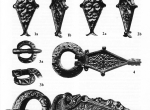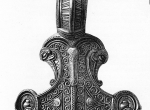Kerbschnitt Style
Kerbschnitt, ornament in relief, another name – chip carving. A method used to decorate the surface of objects with raised and hollowed out designs. This technique was applied to various materials, including wood, clay and metal. In case of metal objects the design would usually be cast first, and then carved and smoothed. The dominant motifs are geometric and had the form of various spirals, multicentric rings, lozenges, zigzag lines, etc. Geometric motifs were sometimes allied with other decorative elements, such as stylized animal heads or motifs adopted from the Animal style. Chip carving could be used in combination with other techniques, for instance, niello. During the →Migration Period chip carved decorative designs distinctive for provincial Roman belt sets (fig. 1.) continue to be in use across much of Europe, especially in Scandinavia, central Europe and lands on the Danube and the Black Sea. Chip carved decoration was applied to elements of the belt set, especially to variously shaped buckle plates but also to brooches (bow brooches →Bow brooch for example - fig. 2.) and other ornaments, sword scabbard mounts and assorted other mounts, such as drinking horn fittings etc.
AB-W
Literature: O. Voss, The Høstentorp silver hoard and its period. A study of a Danish find of scrap silver from about 500 A.D., “Acta Archaeologica” (København) 25, 1954, p. 171-219; G. Haseloff, Die germanische Tierornamentik der Völkerwanderungszeit, Studien zu Salin’s Stil I, Vorgeschichtliche Forschungen 17, Berlin-New York 1981, p. 52-79; M. Axboe, Positive and negative versions in the making of chip-carving ornament, [in:] Festskrift til Thorleif Sjøvold på 70-årsdagen. Universitetets Oldsaksamlings Skrifter. Ny rekke 5, Olso 1984, p. 31-42; H.W. Böhme, Bemerkumgen zum spätrömischen Militärstil, [in:] H. Roth (ed.), Zum Problem der Deutung frühmittelaltericher Bildinhalte. Akten des 1 Internationalen Kolloquiums in Marburg a.d. Lahn, 15. bis 19. Februar 1983, Veröff. Vorgesch. Seminar Philipps-Univ. Marburg a.d Lahn. Sonderbd. 4, 1986, p. 25-49.
-
 full resolution
full resolution
Fig. 1. Buckles decorated in the chip carved technique: 1–3 – gilded silver buckles from Taurapilis, eastern Lithuania; 4 – gilded bronze buckle from Vilkyčiai (former Wilkieten), western Lithuania; 5 – gilded silver buckle from Konarzewo, central Poland
-
 full resolution
full resolution
Fig. 2. Relief brooch from Scania, Sweden (B. Salin, Die Altgermanische Thierornamentik, Stockholm 1904, Fig. 128).


